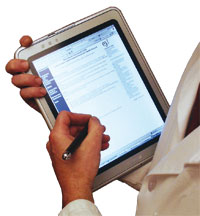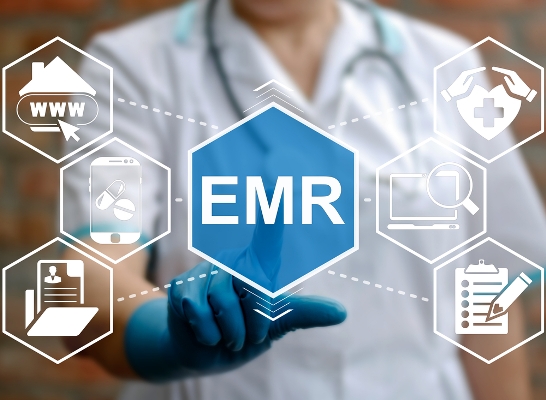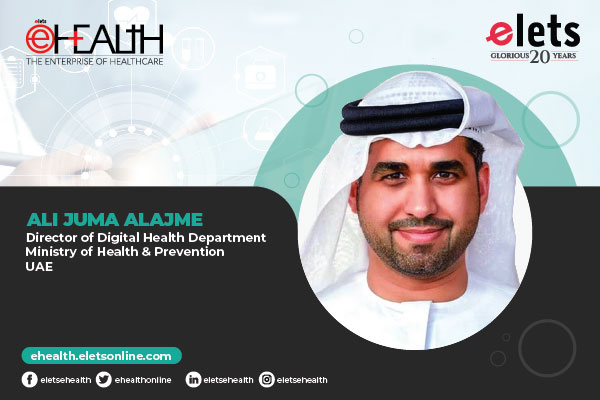Browse the Cart for the Right ‘EMR’
By Shally Makin
 Today, the motto ‘turning digital’ is behind every successful management. EHR/EMR is the database of all patient records, which include both clinical and financial. This technology oriented process is best implemented when a system meets clinical, business, and administrative needs. The hospitals, nowadays, aim to adopt a paperless practice and a virtual assistant for keeping records. Writing prescription is again a time consuming task, therefore an ideal EMR should maintain formulary information by health plan, which provides drug-interaction, checking, allergy and patient education. Keeping a record for a billion people is a tedious work to maintain therefore a scalable process is required to streamline the process of maintaining information. Kiran John, Head – Marketing and Presales, SCIOinspire Corp, says, “EMRs store a wide range of information about patients including demographics; medical history: documentation of events, diagnosis, symptoms, treatment, outcomes, and test results – lab and imagining; associated documentation; and administrative information. In addition to this, EMR information when stored properly (on scalable database architecture) can become a powerful information source for care analytics and risk identification and other clinical information systems can then be bolted onto/integrated with it such as CDSS, CPOE, LIMS, PACS, reminders and alerts etc.”
Today, the motto ‘turning digital’ is behind every successful management. EHR/EMR is the database of all patient records, which include both clinical and financial. This technology oriented process is best implemented when a system meets clinical, business, and administrative needs. The hospitals, nowadays, aim to adopt a paperless practice and a virtual assistant for keeping records. Writing prescription is again a time consuming task, therefore an ideal EMR should maintain formulary information by health plan, which provides drug-interaction, checking, allergy and patient education. Keeping a record for a billion people is a tedious work to maintain therefore a scalable process is required to streamline the process of maintaining information. Kiran John, Head – Marketing and Presales, SCIOinspire Corp, says, “EMRs store a wide range of information about patients including demographics; medical history: documentation of events, diagnosis, symptoms, treatment, outcomes, and test results – lab and imagining; associated documentation; and administrative information. In addition to this, EMR information when stored properly (on scalable database architecture) can become a powerful information source for care analytics and risk identification and other clinical information systems can then be bolted onto/integrated with it such as CDSS, CPOE, LIMS, PACS, reminders and alerts etc.”
| The implementation of EHR is done in two ways: | |
| Big Bang All of core EHR components are deployed at once More disruptive to practice More rapid RoI More rapid implementation More resources required |
Incremental or Modular Specific components one module at a time Less disruptive to practice Longer time period to achieve RoI Longer implementation process Fewer upfront resources required |


 Integrating the system
Integrating the system

The sheer number of products in the market place has created a complex decision to be made. To invest in such a management system a buyer must answer few questions including:
Which is the best EMR/EHR to be used? What is the cost of implementation of EHR/EMR? What is the benefit of implementing such integrated system in your organisation?
Stage 1:This phase is one of the most extensive and time consuming practice to assess in terms of IT in healthcare system. A hardware requirement analysis and staff analysis is done in this phase itself. The phased implementation is done in discrete modules such as lab order entry, messaging, E&M coding, preventive health maintenance, patient tracking, e-prescribing, etc. Proper workflow analysis is required to create flexible timelines.
Stage 2:This phase includes appointing a house manager, reviewing the preparation for installation, map out workflows including the current staff and have proper communication processes identified.
Stage 3:Investment to train staff and prepare them to adopt new technologies, this covers the EHR system configuration, selection process and details of the goals that are archived based on the selection.
Stage 4:Once the plan is finalised, the time lines are agreed by the vendor, then the staff training program is initiated and system testing is initiated.
Stage 5:Post implementation, uation is carried and improvement plan is prepared and validated.
Stage 6:This phase is modified to resolve issues and get staff feedback.
|
Naeem Ahmad, Manager-Business Promotion, Healthcare ITPractice, Akhil Systems, “Akhil EMR is an intuitive, state-of-the-art, and modern technology software solution. The main focus of this application is to bring uniformity and standardization in how various healthcare organizations maintain and share patients’ health records. A seamless integration is built between Akhil HIS and EMR to fill in existing gaps in Indian healthcare system reducing overall healthcare expense. The first version of the EMR has already been launched in the US market. The software will also be launched in India by July 2011.” “The main focus of this application is to bring uniformity and standardization in how various healthcare organizations maintain and share patients’ health records.”
|
|
“He strongly believes that, “We should not aim for an EMR that simply allows you to record patient data. Rather aim for a system that provides some level of decision support” |
|
“He feels, “Strengthening HIS functionality will result a better EMR system in the industry” |
 Dr. Neena Pahuja, Chief Information Officer, Max Healthcare opines, “We are in the process of implementing WorldVista, which is an open source EHR. Dell service has implemented it as an open source product. We have already started working on benefits tracking. As a first step, the data for KRAs to be tracked has already been baselined.” Dr. Neena Pahuja, Chief Information Officer, Max Healthcare opines, “We are in the process of implementing WorldVista, which is an open source EHR. Dell service has implemented it as an open source product. We have already started working on benefits tracking. As a first step, the data for KRAs to be tracked has already been baselined.”
“She annotates,There is no product that is ‘perfect’. Be open to changing your processes if you are implementing a product” |
 Kiran John, Head – Marketing and Presales, SCIOinspire Corp, ” Pricing depends on number of beds, modules being purchased, sophistication, present infrastructure, level of training required and so on, which then gets factored into a price range. The key inference being that the cost of implementing EMR is considerably lower today owning to these new technologies and will continue to decrease.” Kiran John, Head – Marketing and Presales, SCIOinspire Corp, ” Pricing depends on number of beds, modules being purchased, sophistication, present infrastructure, level of training required and so on, which then gets factored into a price range. The key inference being that the cost of implementing EMR is considerably lower today owning to these new technologies and will continue to decrease.”
“The key inference being that the cost of implementing EMR is considerably lower today owning to these new technologies and will continue to decrease” |
EHR implementation helps an organisation to improve healthcare quality, reduce healthcare costs, prevent medical errors, improve administrative efficiencies, reduce paperwork, and increase access to affordable healthcare
Rationalising Benefits
EHR implementation helps an organisation to improve healthcare quality, reduce healthcare costs, prevent medical errors, improve administrative efficiencies, reduce paperwork, and increase access to affordable healthcare. There is greater patient safety, improved communication and performance, and the ability to access patient records remotely. It can also help in planning demographic health pattern for proper healthcare delivery. Kiran John adds, “EMRs also provide physicians and specialists a comprehensive view of patient information thereby reducing the medical errors, misdiagnosis, unnecessary utilisation, duplication of tests, and supporting P4P (pay for performance) models. At the aggregate level, easy access to comprehensive medical records are critical to lowering overall healthcare cost, fraud, abuse and waste in the system. With fraud and abuse become more complex and clinical in nature, having easy access to this information helps payers curb provider fraud considerably.”
Challenges
On the other hand, there are certain obstacles, the healthcare professionals face while implementing an EHR system. There are factors regarding speed and technology dealing with different systems. The change in workflow needs to accommodate new technology along with cost for implementation. Presently, in India the healthcare system has recently introduced EHR and EMR. There is still a lot to be explored in the field. Although a lot of private hospitals are maintaining EMR record but EHR practice still lags behind. Only a minuscule community of doctors is enthusiastic about the implementation of new technology. It is really important for government to take initiatives regarding the use of IT in rural health and encourage companies to project it forward. It shows that still a lot is to be done in terms of making the system aware about the new software and technology, which are reducing manual work.
The system is largely implemented through computers, which is extremely cost-effective using non-proprietary technology which can be used even at national level without any further modifications. The initial cost of implementing shows the economics and the tangible benefits paying back the cost within 1-2 years.
The open source EMR software is used in hospitals worldwide, which will support and upgrade. The software implemented is an enterprise level, and can save millions of tax-payers’ money if implemented at a national level. The whole process of implementation is not a one day affair. We all need to decide and revolutionize the way we deal with the record and storage of medical and patient records. As per the rules and regulations, the records need to be stored for at least a period of 2 years, in order to keep a track of it; this new software has given a chance to the medical professionals to keep a track of each and every case.
Implementing EMR into the system with digitising and storing records in electronic form needs professionals to weigh cost and benefit equally by properly scrutinising the market and applying the perfect integrated system.
uld_count:
Cookie not set
Value 1: 0
Value 2: 10






 Dr. Karanvir Singh, Head of HIS Implementation, Sir Ganga Ram Hospital (SGRH), Delhi has been using TrakCare from Intersystems (USA) since 2005. The initial acquisition cost is `1 crore for the installation in the hospital. He adds, “We have already recovered the initial acquisition cost in financial terms. Benefits from EMR, i.e. continuity of medical records, etc. are not in financial terms but are in terms of better medical care. We have benefitted from that also.”
Dr. Karanvir Singh, Head of HIS Implementation, Sir Ganga Ram Hospital (SGRH), Delhi has been using TrakCare from Intersystems (USA) since 2005. The initial acquisition cost is `1 crore for the installation in the hospital. He adds, “We have already recovered the initial acquisition cost in financial terms. Benefits from EMR, i.e. continuity of medical records, etc. are not in financial terms but are in terms of better medical care. We have benefitted from that also.” Sanveesh MV, Manager Systems, Apollo, Ahmadabad has Wipro as their provider for HIS, which contains minimal features of EMR. Since EMR is a part of HIS, there was no extra cost of installation. Introduction of EMR/EHR into the hospital administration would be more affordable and form an essential part of HIT.
Sanveesh MV, Manager Systems, Apollo, Ahmadabad has Wipro as their provider for HIS, which contains minimal features of EMR. Since EMR is a part of HIS, there was no extra cost of installation. Introduction of EMR/EHR into the hospital administration would be more affordable and form an essential part of HIT.










